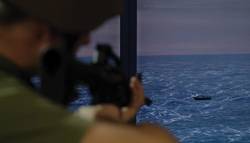The recent incident involving the MV Enrica Lexie off the coast of India highlights the increasing carriage on merchant vessels of armed security guards (whether military personnel or private contractors) to ward off attacks by pirates and robbers. I will not speculate as to what may have occurred on board the tanker or on the fishing vessel where two individuals unfortunately lost their lives. Suffice it to say that this is a tragic incident for all involved.
The International Maritime Organization (IMO) has reluctantly acquiesced to this trend of weaponizing merchant vessels by promulgating guidelines for flag states, coastal states, and ship owners/operators regarding use of privately contracted armed security personnel. The guidance empathically states that the master retains overriding authority for acts undertaken on board the vessel. It also states that the security personnel should have rules for the use of force, as agreed between the ship owner, the master, and the security personnel.
Unfortunately, there is very little guidance available to the owner and the master to judge whether a particular security company’s rules for the use of force are adequate and appropriate.
Since the master and, to a lesser extent, the ship owner are ultimately responsible for everything that occurs on a merchant vessel, it behooves them to understand the rules for use of force that are to be implemented by the armed security guards. It is also important that the master and owner be able to distinguish between adequate and inadequate rules.
The principles discussed below generally apply in common-law countries. For legal principles in specific jurisdictions, expert legal advice should be sought.
The basic construct of this discussion involves the right of self-defense and/or the defense of others. An individual is entitled to use force, up to and including deadly force, to thwart an attack upon that individual or another when and only when the attack poses an imminent threat of great bodily harm or death. In other words, you may not shoot someone who merely slaps your face. You may, though, be entitled to use deadly force against someone who attacks you with a gun, knife, or other deadly instrument (e.g., a crowbar). Whether the attack poses an imminent threat of great bodily harm or death depends in large part on weapon being employed. For example, a crowbar being wielded by an attacker 100 meters away would not be considered an imminent threat, whereas an attacker with an AK-47 at the same distance would constitute an imminent threat. Even when an imminent threat is presented, that does not mean you are required to use deadly force in such circumstance, only that the use of deadly force may be reasonable in those circumstances.
Your resistance to an attack must be proportional to the threat presented. If you can safely retreat, you should do so. For example, if pirates in a skiff attack your vessel and fire their weapons, you should (if able) increase speed and change course to evade the pirates. If that is not feasible, you should warn the pirates off. If warning shots are to be fired, it is important the shots be fired so as not to result in unintended injury. Several years ago, military personnel on a US vessel fired warning shots in front of a small boat that was approaching the US vessel. The shots were fired in front of the approaching boat. Unfortunately, one of the rounds skipped on the surface of the water and struck an individual on the boat, killing him. It was then learned that the small boat was approaching the US vessel in hopes of selling trinkets – no harm had been intended. In other instances, local fishermen fire their weapons for the purpose of alerting a passing vessel that it is approaching their fishing nets. Again, they are not pirates and are not intending to attack the vessel. Use of deadly force in such circumstance would be inappropriate. Persons using deadly force in either instance would be operating outside the usual and accepted bounds. They and the master could possibly be held responsible for any injuries or damages incurred by an innocent party.
Non-deadly force may be used for self-defense or defense of others; for defense of the vessel; or to prevent theft or damage to property that one is authorized to protect. Non-deadly force may include such things as: maneuvering the vessel to place an attacking boat in its wake; use of sonic booms or dazzling lights; use of fire hoses or monitors; deployment of barbed or concertina wire; and deployment of an electrified fence around the vessel’s gunwales. The goal of non-deadly force is for the attacker to be deterred, without killing or severely injuring the attacker.
Masters should carefully consider all circumstances when employing force and resort to the use of deadly force or to authorizing armed security guards on board the vessel to use deadly force only when there is imminent danger of death or great bodily harm. The inappropriate use of deadly force may result in civil and/or criminal charges against the armed security personnel, the master, and the owner. Reasonable care and careful consideration is required before one exercises or authorizes the use of deadly force. Masters and owners should also carefully review the rules for use of force by armed security guards prior to embarkation of those guards on the vessel. The rules should fully address the restrictions on use of force, including a provision that deadly force may only be used with the express permission of the master.



